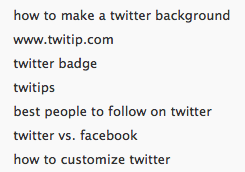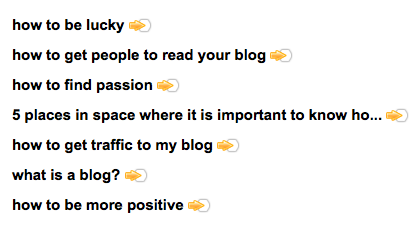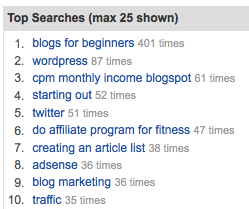Solve a Problem - 7 Ways to Identify Reader Problems

Today’s task in the 31 Days to build a better blog project is a ‘writing’ oriented task and it is all about solving problems.
Your task is to write a post that solves a problem that your readers (or potential readers) have.
This is a task that most successful bloggers build into every single day of their blogging. Here’s their motivation:
If you’ve solving problems:
- you’ll make an impression upon people
- those people are more likely to return to your blog
- those people are more likely to tell others about your blog
How to Identify Problems to Solve:
For some bloggers identifying a problem that their readers will have is easy - they have a lot of readers and have their finger on the pulse of their needs. However it isn’t that easy for many newer bloggers with smaller and less vocal readers.
7 Methods for Identifying Problems to Solve on Your Blog
1. Solve Your Own Problems
My favorite way to identify needs and problems of others is to take note of my own. In my experience, when I have a problem I’m not likely to be alone. So instead of just solving your problems for yourself and moving on - why not capture the solution and add it to your blog so that others can benefit from it.
I was recently asked by a Twitter follower how she should start her blog. She was a little apprehensive of getting going and not sure how to start out. My answer was to write about a problem that she’d had and how she solved it. I can’t think of a much better way to get a blog going - right from day 1 it signals to readers that you’re interested in solving problems.
A great exercise to do to identify your own previous problems is to sit down with a notepad and pen or a laptop and text document and simply brainstorm all of the things you’ve learnt, overcome, discovered or solved when it comes to the topic that you cover on your list. Also list questions that you remember asking others about or problems that you might have researched yourself privately.
Having done this you should end up with a good list of potential posts to write on your blog.
2. Look for Questions in Search Referrals
Once your blog has been going for a while there are ways to tap into your readership and discover the problems that they have. One of these that is particularly useful when readers don’t verbalize to you their needs and problems is to look at how and why they access your blog (and what they do when they arrive).
One way to do this is to look at the terms that people are typing into search engines to arrive on your site. Sometimes the most common keywords can illuminate a topic that people have a need or problem in.
For example on my Twitter Tips blog I have the WP stats plugin installed. While not as advanced as some stats packages it does show me the most commonly used keywords that people arrive on my site having typed into search engines. Here’s a screenshot of part of the list of keywords:

These are just 7 of many hundreds of terms that people have typed into Google to and there are a few potential problems that people obviously have. Some way to know how to make a background image for Twitter, others want to know about twitter badges, others are looking for suggestions on who to follow on Twitter while others are tossing up between Twitter and Facebook while others are looking for information on how to customize Twitter.
From those 7 search terms I’ve identified 5 problems that people have on Twitter!
The same information can be gleaned from most web statistics packages such as Google Analytics.
Another great tool for identifying such terms and honing in particularly on ‘questions’ that people are asking when they arrive on your site is 103bees. To use it you need to be able to add a little javascript code to your blog’s footer or header - but once you’ve done that it’ll show you what keywords people are typing into search engines but also particularly highlight the questions people are asking.
So here on ProBlogger people have arrived on this site in the last few minutes asking:

Again - there are some real life ‘needs’ and problems that people have.
Keep in mind that with both of the above techniques you’re relying on your site ranking well for certain keywords that you’ve already used. So the reason I have people arriving on my blog searching for ‘how to be lucky‘ is because I’ve already written about that exact topic (so I probably don’t need to write another post on that exact topic). However you will find in the mix that people ask questions that you’ve not written specifically about.
3. Analyze Internal Searches
Another related way to find information on what your current readers problems and needs are is to watch what they search for when they are on your blog. This will show you what those arriving on your blog are still searching for once they’ve arrived. This is great because it shows you questions that they’re asking that you’ve often not already written about.
There are a few tools that show you internal search keywords. One I’ve is:
Lijit - Lijit is a search box that you put on your sidebar or in your navigation area instead of your normal search box. In many ways it performs the same functions as far as your readers are concerned in that it allows them to search your blog - however it also gives publishers a large array of useful information on what those searches are for. For example Lijit shows me that people on ProBlogger have searched for:

Not only that - it also produces a list of searches that people have done on your blog that you have NO RESULTS for:

While that list includes some rather ‘odd’ results it also produces some very useful information at times also and gives a snapshot into what readers are looking for information about!
4. Ask Readers for Questions
Another method that can be well worthwhile is to directly ask readers for their questions or about the needs and challenges that they face.
This of course assumes that you have some readers (it might not be for those just starting out) and assumes that they are comfortable in giving you a response.
There are a variety of ways of doing this:
- Write a post asking for questions
- Email a handful of most recent comment leavers asking if they have anything they need help with
- Set up a contact form that acts as a ‘question box’
- Run a Survey for readers
- Set up a sidebar and/or in post poll that gives people a set of options to show you their most pressing needs (this allows some anonymity)
I’ve done each of these and all can be well worth your time to do.
5. Look for Problems on other Sites
This one can be particularly good for those just starting out who don’t have current readers to ask. It simply involves finding a forum, blog or social networking site that is relevant to your niche and surfing through threads of conversation looking for the type of questions that people ask.
You’ll probably want to concentrate on doing this in larger sites that get the amount of comments needed for this but once you spend some time on most good sized forums you’ll see a range of questions that are asked over and over again.
6. Use Social Media to Gather Questions
A place that I personally am getting more and more inspiration for posts is Twitter and other social networking sites.
Twitter is a great place for collecting questions from real people with real needs and problems. I mainly do this in two ways:
- Asking for Questions - every now and again I simply tweet that I’m looking for a few questions to base posts on.
- Watch lists - I have a few keywords that I particularly look to track and monitor the use of on Twitter (I do this through my Twitter Client TweetDeck). I’ve written more about setting up watch lists earlier in 31DBBB but many of the times I see keywords used I see questions being asked. I try to answer these questions on Twitter but also often use them as inspiration for longer blog posts.
7. Ask ‘real life’ Friends and Family
Lastly - don’t forget your real life friends, family and work colleagues. Many of the conversations you have in day to day conversation reveal the types of struggles and challenges that people face. While you’ll want to keep private conversations private they could be a great source of inspiration for posts.
I actually find that family gatherings with extended family are a great time for me to tap into what people think about the topics that I write about. For example at one family gathering a family member asked me if he was holding his digital camera right. He was almost a little embarrassed to ask it as it was such a basic thing but as I was answering I realized that other beginners in using cameras would have the same question - hence How to Hold a Digital Camera came into being.
Post from: Blog Tips at ProBlogger.
Solve a Problem - 7 Ways to Identify Reader Problems [Day 16 - 31DBBB]
Join me at Social Media Success Summit 2009
Posted: 20 Apr 2009 04:40 PM PDT
I wanted to take a few minutes today to let you know about an event that I’m excited to be participating in that is fast approaching.
The event is the Social Media Success Summit 2009.
The event is a live online event (although you have access to recordings if you can’t make the live components) and it is being organized by Michael A. Stelzner from White Paper Source. As the name suggests - this event is all about social media and discovering how to use tools like Twitter, LinkedIn and Facebook to grow your business.

Speakers are all experts in different aspects of social media and include:
- Gary Vaynerchuck (Wine Library TV)
- Mari Smith (Facebook Expert)
- Jason Alba (Linked In Expert)
- Ann Handley (chief content officer from MarketingProfs)
- Brian Clark (CopyBlogger)
- Chris Garrett (Co Author of ProBlogger the Book)
- Denise Wakeman (BlogSquad)
- Michael A. Stelzner (White Paper Guru)
The sessions start on May 26 and happen over a number of days to give you time to digest it all.
I’m doing a panel discussion on 3rd June with Brian Clark on ‘The Future of Social Media: What’s Going to be Hot and What’s Not).
The Social Media Success Summit 2009 is based around live calls where you get to interact with those presenting but also gives you access to recordings and transcripts of the calls if you want to review them later or can’t make the live calls.
There is currently a $200 early bird discount. I hope that this is something that will interest you and hope to see you in class!
No comments:
Post a Comment